Outlandish oven! Tandoor: what is it, how to build it yourself, photo
You are viewing the section Tandoor, located in the large section DIY construction.
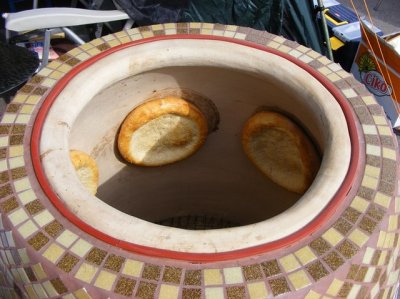
Eastern cuisine is famous for its dishes cooked in a special oven – tandoor.
This design isand a hemisphere with a round opening in the center or on the wall.
The main purpose of the device today is cooking: bread, meat, poultry, vegetables, etc. But initially, the tandoor was used for heating rooms and even firing metal and ceramic products.
Tandoor: what is it, what is it for. Types: Armenian, Georgian
In the countries of the East, a wide variety of tandoors are used, and each country has its own design features.
Yes, correct Armenian stove (tonir) completed in the form of a well (as in the photo below). It is installed in the ground and lined with bricks. It was originally used for warming up for medicinal purposes, cooking and heating houses. Nowadays, bread is baked in the Armenian tonir. Since 2012 An annual competition for cooking dishes in a tonir (tundir) is held in Armenia.
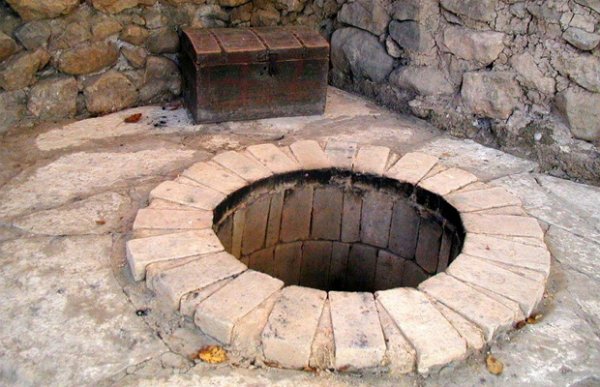
Photo 1. Armenian tandoor. The oven is made in the form of a well, the walls of which are lined with bricks.
Georgian version (tone) — a brick and clay structure, usually horizontal or earthen, in which the famous Georgian bread is baked — ShotiIn large cities of Georgia, you can see mainly vertical ovens made of stone.
Among the sedentary peoples of the East (Uzbeks and Tajiks) When building a house, it is customary to install a portable ceramic tandoor in the backyard, in which traditional flatbreads and samsa are baked. The Turkmen tandoor is also called tone.
The oven is quite picky about fuel. So, in the homeland for its heating use saxaul (an ornamental shrub growing on desert sands), less commonly - elm or plane tree. Since such plants cannot be found in Russia, firewood can be used as fuel various tree species (except conifers).
Attention! It is forbidden take pellets or charcoal: they will give too much heat and the product will simply crack. It is better to refrain from using them. coal: in this case, the device will be permanently saturated with coke gases and will become smelly and poisonous.
Horizontal and vertical stoves
Eastern stoves According to their design, they differ:
- by location features: mobile options and stationary:
- by fuel used: electrical And wood burning.
Conventionally, tandoors are divided into two main types: vertical and horizontal.
The first ones consist of several groups. The most primitive is considered to be earth structure. Its structure is a hole dug in the ground, lined with bricks, which are first coated with clay. Usually, such models are equipped with a pipe that supplies air to the firewood if the structure is closed with a lid. An earthen tandoor can be installed both indoors and outside. In terms of its functionality, it similar to barbecue.

There are also vertical ground stationary structures. They can be either ring-shaped or square-shaped. They are made using one of two main methods: ribbon or sculpture.
In the first case, clay is used mixed with sheep/camel wool, rolled into rollers and laid out in the shape of a cone/cylinder.
There are also “modernized” models of the fireplace, which are manufactured made of firebrick.
In recent years, they have become very popular portable models. Inside, made of fireclay, the structure, equipped with metal handles for convenience, is a blower (at the bottom). In the neck there is a removable vertical device for skewers.
Ground tonnages (both stationary and portable models) no worse than a barbecue are suitable for cooking poultry, meat, fish, vegetables, etc. They are used to prepare cabbage soup, various porridges, milk and aromatic tea.
The tonur is much more economical than a barbecue in terms of fuel consumption. For example, it takes about 3 times less firewood.
Horizontal toners are different impressive weight (more than 80 kg) and are installed on a foundation of height about 1 m. There is a hemispherical firebox inside the structure. The base is made of brick or stone. The formwork is filled with clay concrete.
Reference. Horizontal models similar to a Russian stove, but they also have a fundamental difference - no chimney. This makes it possible to fully use not only the horizontal surface of the oven, but also its walls (you can put flatbreads, samsa and other oriental spices on the hearth).
The best ideas for making a tandoor oven with your own hands
When there are no necessary materials at hand, true craftsmen use unusual elements that allow them to make non-traditional, but no less effective products. Tandoor are made from the following types of scrap materials:
- From flower pots
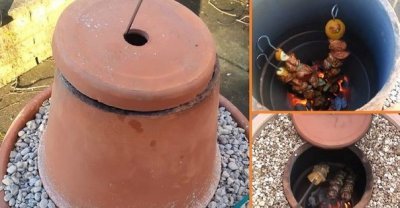
This version of the stove was suggested by craftsmen from the Forumhouse forum.
To make it you only need a couple of fairly large pots (dimensions not less than 35x30 cm), fireclay brick And thermal insulation layer (For example, sand or a mixture of expanded clay and soil).
First, a base is prepared (a concrete screed or several bricks), on which one of the pots is placed, and then covered with another one and fixed with a clay solution, upside down.
The structure is lined with bricks/concrete blocks, maintaining a certain distance, which is filled with thermal insulation.
- From the barrel
Barrel in this case serves as a template. First, it is treated inside with sunflower oil, then coated with a layer of thick solution consisting of fireclay, sheep wool and sand. When it hardens, the barrel is dismantled, and thus a simple version of tonura is obtained.
- Made of brick
A foundation is prepared for a brick oven: a shallow hole is dug, a sand layer is poured in, a metal grate is laid and cement mortar is poured in. Firebrick is laid on a carefully leveled and dried concrete foundation using the same firebrick mortar. The brick must be coated with a thick layer (about 5 cm) fireclay clay and is covered natural stone (if desired).
Photos of finished projects
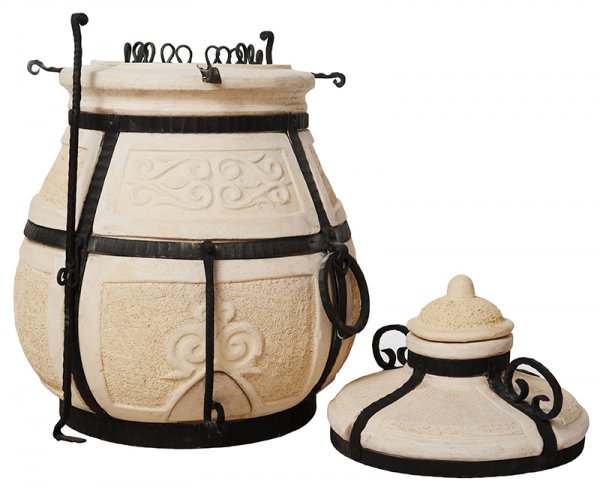
Photo 2. A portable vertical tandoor option. It has a lid and hooks for holding skewers.
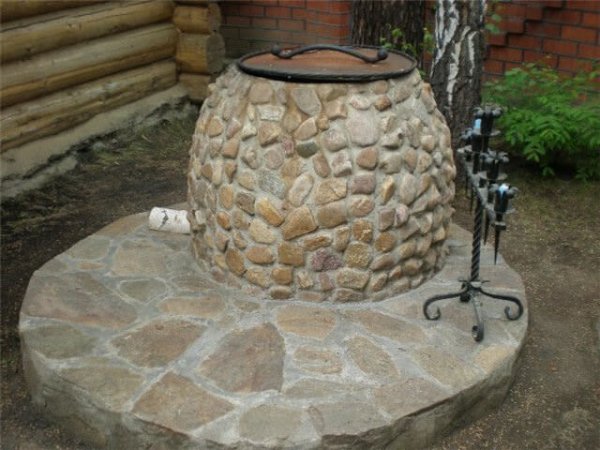
Photo 3. Georgian vertical tandoor. In this photo, the device is finished with decorative stone.
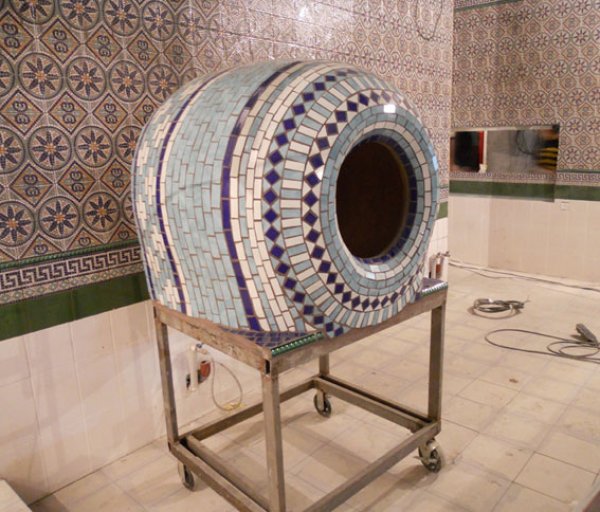
Photo 4. A horizontal tandoor oven powered by electricity. The facing is made of tiles.
Useful video
Watch the video, which explains what a tandoor is, how to cook in it, and offers a recipe for duck in sour cream sauce for cooking in such an oven.
Useful tips
Tandoor is certainly equally good for cooking all kinds of products regardless of its design features. But when choosing a suitable oven model, nevertheless, There are some things to pay attention to:
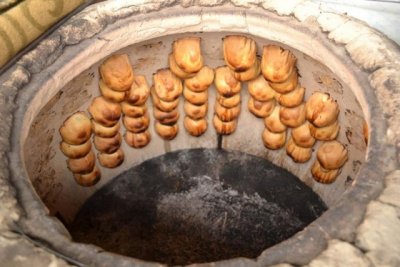
- The height of the product and the diameter of its neck. These two indicators must be harmonious: the higher the product and the narrower its neck, the better the quality of the dishes will be.
- Weight of the structure. This indicator directly depends on the previous one: the thicker the stove, the heavier it is. But a too heavy tonur will not do either: if it weighs more than 200 kg, it is worth considering the advisability of such a purchase.
- Thickness of the product walls. The impressive thickness of the walls is the first thing that true connoisseurs of food cooked in a tonura notice. The thicker product, the better and longer it will retain heat, and, therefore, the quality of the prepared dishes (as well as their range) will be at its best.
- Additional components. The oven must come with ash-pit, since it is an important element of it. In some designs, there are many holes at the bottom (supposedly for better cooking), which are not completely closed. This is an absolute failure to comply with the technology. Skewers with a bend — another element for the tandoor. They must be included with the oven.















Comments